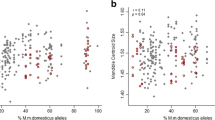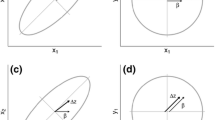Abstract
Hybridization can generate phenotypes departing from the parental range through many processes: increased variance due to increased heterozygosity, decreased phenotypic integration and altered covariation structure due to changes in the expression of (co)variation generating developmental processes, and transgression that may arise from epistasis and compensatory genes. Morphometric assessment of shape differentiation, variance and covariance may shed light on these processes, especially for complex characters for which the genetic basis has not yet been assessed. The shape of the first upper molar was thus quantified in a cross between inbred strains of the two European subspecies of the house mouse (Mus musculus domesticus and M. m. musculus). Hybrids appeared as moderately transgressive. Morphological variance was increased in F2s, back to levels observed in wild populations. The pattern of variance–covariance was different between the two parental strains, but restored to a wild-type structure in F2s. Finally, F2s displayed a degree of morphological integration comparable to wild populations but lower than observed in the parental strains. This is interpreted as the result of the reshuffling of the standing genetic variation in hybrids that should have restored the expression of (co)variance generating processes made ineffective in parents due to random allele fixation of some loci. Inter-parental differentiation was more important in regions of the tooth developing early during embryogenesis, whereas transgression was more pronounced in late developing regions. Mutations may more easily generate important geometric differences early during tooth development, occurring as a cascade of signalization from the first cusp to initiate onward. Epistasis and constraints of neighboring parts may be more important later, promoting transgression and impeding differentiation.








Similar content being viewed by others
References
Albertson, R. C., Streelman, J. T., Kocher, T. D., & Yelick, P. C. (2005). Integration and evolution of the cichlid mandible: The molecular basis of alternate feeding strategies. Proceedings of the National Academy of Sciences, USA, 102(45), 16287–16292.
Alibert, P., Fel-Clair, F., Manolakou, K., Britton-Davidian, J., & Auffray, J.-C. (1997). Developmental stability, fitness, and trait size in laboratory hybrids between European subspecies of the house mouse. Evolution, 51(4), 1284–1295.
Alibert, P., Renaud, S., Dod, B., Bonhomme, F., & Auffray, J.-C. (1994). Fluctuating asymmetry in the Mus musculus hybrid zone: A heterotic effect in disrupted co-adapted genomes. Proceedings of the Royal Society, London B, 258, 53–59.
Amaral, A. R., Lovewell, G., Coelho, M. M., Amato, G., & Rosenbaum, H. C. (2014). Hybrid speciation in a marine mammal: The Clymene Dolphin (Stenella clymene). PLoS ONE, 9(1), e83645. doi:10.1371/journal.pone.0083645.
Auffray, J.-C., Alibert, P., Latieule, C., & Dod, B. (1996). Relative warp analysis of skull shape across the hybrid zone of the house mouse (Mus musculus) in Denmark. Journal of Zoology, London, 240, 441–455.
Bell, M. A., & Travis, M. P. (2005). Hybridization, transgressive segregation, genetic covariation, and adaptive radiation. Trends in Ecology and Evolution, 20(7), 358–361.
Boursot, P., Auffray, J.-C., Britton-Davidian, J., & Bonhomme, F. (1993). The evolution of house mice. Annual Review of Ecology and Systematics, 24, 119–152.
Brem, R. B., & Kruglyak, L. (2005). The landscape of genetic complexity across 5,700 gene expression traits in yeast. Proceedings of the National Academy of Sciences, USA, 102(5), 1572–1577.
Cho, S.-W., Lee, H.-A., Cai, J., Lee, M.-J., Kim, J.-Y., Ohshima, H., et al. (2007). The primary enamel knot determines the position of the first buccal cusp in developing mice molars. Differentiation, 75(5), 441–451. doi:10.1111/j.1432-0436.2006.00153.x.
Debat, V., Alibert, P., David, P., Paradis, E., & Auffray, J.-C. (2000). Independence between developmental stability and canalization in the skull of the house mouse. Proceedings of the Royal Society of London, Biological Sciences (serie B), 267, 423–430.
Debat, V., Milton, C. C., Rutherford, S., Klingenberg, C. P., & Hoffmann, A. A. (2006). Hsp90 and the quantitaive variation of wing shape in Drosophila melanogaster. Evolution, 60(12), 2529–2538.
Dittrich-Reed, D. R., & Fitzpatrick, B. M. (2013). Transgressive hybrids as hopeful monsters. Evolutionary Biology, 40, 310–315. doi:10.1007/s11692-012-9209-0.
Dray, S., & Dufour, A.-B. (2007). The ade4 package: Implementing the duality diagram for ecologists. Journal of Statistical Software, 22, 1–20.
Hallgrímsson, B., Jamniczky, H. A., Young, N. M., Rolian, C., Parsons, T. E., Boughner, J. C., et al. (2009). Deciphering the palimpsest: Studying the relationship between morphological integration and phenotypic covariation. Evolutionary Biology, 36, 355–376.
Hallgrímsson, B., & Lieberman, D. E. (2008). Mouse models and the evolutionary developmental biology of the skull. Integrative and Comparative Biology, 48(3), 373–384.
Jamniczky, H. A., & Hallgrímsson, B. (2011). Modularity in the skull and cranial vasculature of laboratory mice: Implications for the evolution of complex phenotypes. Evolution and Development, 13(1), 28–37.
Jernvall, J., & Thesleff, I. (2000). Reiterative signaling and patterning during mammalian tooth morphogenesis. Mechanisms of Development, 92, 19–29.
Klingenberg, C. P. (2009). Morphometric integration and modularity in configurations of landmarks: Tools for evaluating a priori hypotheses. Evolution and Development, 11(4), 405–421.
Klingenberg, C. P. (2013). Cranial integration and modularity: Insights into evolution and development from morphometric data. Hystrix, The Italian Journal of Mammalogy, 24(1), 43–58.
Klingenberg, C. P., Mebus, K., & Auffray, J.-C. (2003). Developmental integration in a complex morphological structure: How distinct are the modules in the mouse mandible? Evolution and Development, 5(5), 522–531.
Klingenberg, C. P., & Navarro, N. (2012). Development of the mouse mandible: A model system for complex morphological structures. In M. Macholán, S. J. E. Baird, P. Munclinger, & J. Piálek (Eds.), Evolution of the house mouse (pp. 135–149). Cambridge: Cambridge University Press.
Kuhl, F. P., & Giardina, C. R. (1982). Elliptic Fourier features of a closed contour. Computer Graphics and Image Processing, 18, 259–278.
Labonne, G., Navarro, N., Laffont, R., Chateau-Smith, C., & Montuire, S. (2014). Developmental integration in a functional unit: Deciphering processes from adult dental morphology. Evolution and Development, 16(4), 224–232. doi:10.1111/ede.12085.
Landin, M. A., Nygård, S., Shabestari, M. G., Babaie, E., Reseland, J. E., & Osmundsen, H. (2015). Mapping the global mRNA transcriptome during development of the murine first molar. Frontiers in Genetics, 6, 47.
Larsen, P. A., Marchán-Rivadeneira, M. R., & Baker, R. J. (2010). Natural hybridization generates mammalian lineage with species characteristics. Proceedings of the National Academy of Sciences, USA, 107(25), 11447–11452. doi:10.1073/pnas.1000133107.
Millien, V., & Bovy, H. (2010). When teeth and bones disagree: Body mass estimation of a giant extinct rodent. Journal of Mammalogy, 91(1), 11–18.
Mitteroecker, P., & Bookstein, F. L. (2008). The evolutionary role of modularity and integration in the hominoid cranium. Evolution, 62(4), 943–958.
Monteiro, L. R., Bonato, V., & Reis, S. F. D. (2005). Evolutionary integration and morphological diversification in complex morphological structures: Mandible shape divergence in spiny rats (Rodentia, Echimyidae). Evolution and Development, 7(5), 429–439.
Nichols, P., Genner, M. J., Oosterhout, C. V., Smith, A., Parsons, P., Sungani, H., et al. (2014). Secondary contact seeds phenotypic novelty in cichlid fishes. Proceedings of the Royal Society, London B, 282, 20142272.
Nolte, A. W., & Sheets, H. D. (2005). Shape based assignments tests suggest transgressive phenotypes in natural sculpin hybrids (Teleostei, Scorpaeniformes, Cottidae). Frontiers in Zoology, 2, 11. doi:10.1186/1742-9994-2-11.
Oliveira, R., Godinho, R., Randi, E., & Alves, P. C. (2008). Hybridization versus conservation: Are domestic cats threatening the genetic integrity of wildcats (Felis silvestris silvestris) in Iberian Peninsula? Philsophical Transaction of the Royal Society B, 363, 2953–2961. doi:10.1098/rstb.2008.0052.
Orsini, P., & Cheylan, G. (1988). Les rongeurs de Corse: Modifications de taille en relation avec l’isolement en milieu insulaire. Bulletin d’Ecologie, 19(2–3), 411–416.
Parsons, K. J., Son, Y. H., & Albertson, R. C. (2011). Hybridization promotes evolvability in African cichlids: Connections between transgressive segregation and phenotypic integration. Evolutionary Biology, 38, 306–315. doi:10.1007/s11692-011-9126-7.
Pavlicev, M., Cheverud, J. M., & Wagner, G. P. (2009). Measuring morphological integration using eigenvalue variance. Evolutionary Biology, 36, 157–170.
Peterkova, R., Lesot, H., Vonesch, J. L., Peterka, M., & Ruch, J. V. (1996). Mouse molar morphogenesis revisited by three dimensional reconstruction. I. Analysis of initial stages of the first upper molar development revealed two transient buds. International Journal of Developmental Biology, 40, 1009–1016.
Randi, E. (2008). Detecting hybridization between wild species and their domesticated relatives. Molecular Ecology, 17, 285–293. doi:10.1111/j.1365-294X.2007.03417.x.
Raufaste, N., Orth, A., Belkhir, K., Senet, D., Smalda, C., Baird, S. J. E., et al. (2005). Inferences of selection and migration in the Danish house mouse hybrid zone. Biological Journal of the Linnean Society, 84, 593–616.
Renaud, S. (2005). First upper molar and mandible shape of wood mice (Apodemus sylvaticus) from northern Germany: Ageing, habitat and insularity. Mammalian Biology, 70(3), 157–170.
Renaud, S., Alibert, P., & Auffray, J.-C. (2009a). Mandible shape in hybrid mice. Naturwissenschaften, 96, 1043–1050. doi:10.1007/s00114-009-0563-4.
Renaud, S., Alibert, P., & Auffray, J.-C. (2012). Modularity as a source of new morphological variation in the mandible of hybrid mice. BMC Evolutionary Biology, 12, 141.
Renaud, S., Auffray, J.-C., & Michaux, J. (2006). Conserved phenotypic variation patterns, evolution along lines of least resistance, and departure due to selection in fossil rodents. Evolution, 60(8), 1701–1717.
Renaud, S., Dufour, A.-B., Hardouin, E. A., Ledevin, R., & Auffray, J.-C. (2015a). Once upon multivariate analyses: When they tell several stories about biological evolution. PLoS ONE, 10(7), e0132801. doi:10.1371/journal.pone.0132801.
Renaud, S., Gomes Rodrigues, H., Ledevin, R., Pisanu, B., Chapuis, J.-L., & Hardouin, E. A. (2015b). Fast morphological response of house mice to anthropogenic disturbances on a Sub-Antarctic island. Biological Journal of the Linnean Society, 114, 513–526.
Renaud, S., Hardouin, E. A., Pisanu, B., & Chapuis, J.-L. (2013). Invasive house mice facing a changing environment on the Sub-Antarctic Guillou Island (Kerguelen Archipelago). Journal of Evolutionary Biology, 26, 612–624.
Renaud, S., Pantalacci, S., & Auffray, J.-C. (2011). Differential evolvability along lines of least resistance of upper and lower molars in island mouse mice. PLoS ONE, 6(5), e18951. doi:10.1371/journal.pone.0018951.
Renaud, S., Pantalacci, S., Quéré, J.-P., Laudet, V., & Auffray, J.-C. (2009b). Developmental constraints revealed by co-variation within and among molar rows in two murine rodents. Evolution and Development, 11(5), 590–602. doi:10.111/j.1525-142X.2009.00365.x.
Rieseberg, L. H., Archer, M. A., & Wayne, R. K. (1999). Transgressive segregation, adaptation and speciation. Heredity, 83, 363–372.
Sage, R. D., Atchley, W. R., & Capanna, E. (1993). House mice as models in systematic biology. Systematic Biology, 42(4), 523–561.
Salazar-Ciudad, I., & Jernvall, J. (2006). A computational model of teeth and the developmental origins of morphological variation. Nature, 464, 583–586.
Salazar-Ciudad, I., & Marin-Riera, M. (2013). Adaptive dynamics under development-based genotype-phenotype maps. Nature, 497, 361–364.
Selz, O. M., Lucek, K., Young, K. A., & Seehausen, O. (2013). Relaxed trait covariance in interspecific cichlid hybrids predicts morphological diversity in adaptive radiations. Journal of Evolutionary Biology, 27, 11–24.
Stelkens, R., & Seehausen, O. (2009). Genetic distance between species predicts novel trait expression in their hybrids. Evolution, 63(4), 884–897.
Valenzuela-Lamas, S., Baylac, M., Cucchi, T., & Vigne, J.-D. (2011). House mouse dispersal in Iron Age Spain: A geometric morphometrics appraisal. Biological Journal of the Linnean Society, 102, 483–497.
Vigne, J.-D., Cheylan, G., Granjon, L., & Auffray, J.-C. (1993). Evolution ostéométrique de Rattus rattus et de Mus musculus domesticus sur de petites îles: Comparaison de populations médiévales et actuelles des îles Lavezzi (Corse) et de Corse. Mammalia, 57(1), 85–98.
Whitlock, M. C., Phillips, P. C., & Fowler, K. (2002). Persistence of changes in the genetic covariance matrix after a bottleneck. Evolution, 56(10), 1968–1975.
Acknowledgments
We thank F. Fel-Clair, K. Manolakou, A. Orth and A. Zaegel for help and technical assistance during the rearing of the animals. The manuscript benefited from discussions with L. Pallares, S. Pantalacci and A.B. Dufour. We are indebted to the editor Benedikt Hallgrimsson and two anonymous reviewers whose highly constructive comments and careful reading of the manuscript greatly helped us to improve it. This study was supported by the ANR Bigtooth (ANR-11-BSV7-008). This is contribution ISEM 2016-200.
Conflict of interest
The authors declare that they have no conflict of interest.
Author information
Authors and Affiliations
Corresponding author
Rights and permissions
About this article
Cite this article
Renaud, S., Alibert, P. & Auffray, JC. Impact of Hybridization on Shape, Variation and Covariation of the Mouse Molar. Evol Biol 44, 69–81 (2017). https://doi.org/10.1007/s11692-016-9391-6
Received:
Accepted:
Published:
Issue Date:
DOI: https://doi.org/10.1007/s11692-016-9391-6




